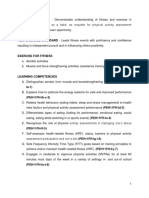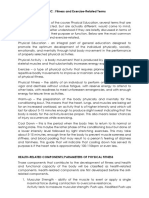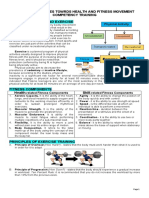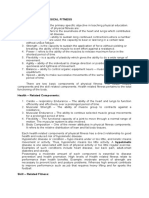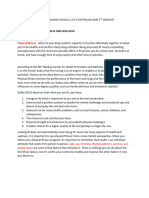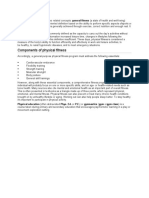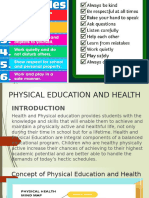0 ratings0% found this document useful (0 votes)
80 viewsExercise Physiology
Exercise Physiology
Uploaded by
Jericho PanisExercise physiology is the study of how the body responds and adapts to physical stress through exercise. It describes the body's physiological responses and adaptations to exercise training in order to maximize human physical potential. Key areas studied include the effects of diet and exercise on health and performance. Exercise physiologists also study how exercise can reduce or reverse disease progression. Developing an understanding of exercise physiology allows one to recognize normal and abnormal responses to exercise and adjust training programs accordingly. It also helps provide quality physical education programs and apply scientific research to optimize health, rehabilitation, and athletic performance.
Copyright:
© All Rights Reserved
Available Formats
Download as PPTX, PDF, TXT or read online from Scribd
Exercise Physiology
Exercise Physiology
Uploaded by
Jericho Panis0 ratings0% found this document useful (0 votes)
80 views27 pagesExercise physiology is the study of how the body responds and adapts to physical stress through exercise. It describes the body's physiological responses and adaptations to exercise training in order to maximize human physical potential. Key areas studied include the effects of diet and exercise on health and performance. Exercise physiologists also study how exercise can reduce or reverse disease progression. Developing an understanding of exercise physiology allows one to recognize normal and abnormal responses to exercise and adjust training programs accordingly. It also helps provide quality physical education programs and apply scientific research to optimize health, rehabilitation, and athletic performance.
Original Title
Exercise-Physiology
Copyright
© © All Rights Reserved
Available Formats
PPTX, PDF, TXT or read online from Scribd
Share this document
Did you find this document useful?
Is this content inappropriate?
Exercise physiology is the study of how the body responds and adapts to physical stress through exercise. It describes the body's physiological responses and adaptations to exercise training in order to maximize human physical potential. Key areas studied include the effects of diet and exercise on health and performance. Exercise physiologists also study how exercise can reduce or reverse disease progression. Developing an understanding of exercise physiology allows one to recognize normal and abnormal responses to exercise and adjust training programs accordingly. It also helps provide quality physical education programs and apply scientific research to optimize health, rehabilitation, and athletic performance.
Copyright:
© All Rights Reserved
Available Formats
Download as PPTX, PDF, TXT or read online from Scribd
Download as pptx, pdf, or txt
0 ratings0% found this document useful (0 votes)
80 views27 pagesExercise Physiology
Exercise Physiology
Uploaded by
Jericho PanisExercise physiology is the study of how the body responds and adapts to physical stress through exercise. It describes the body's physiological responses and adaptations to exercise training in order to maximize human physical potential. Key areas studied include the effects of diet and exercise on health and performance. Exercise physiologists also study how exercise can reduce or reverse disease progression. Developing an understanding of exercise physiology allows one to recognize normal and abnormal responses to exercise and adjust training programs accordingly. It also helps provide quality physical education programs and apply scientific research to optimize health, rehabilitation, and athletic performance.
Copyright:
© All Rights Reserved
Available Formats
Download as PPTX, PDF, TXT or read online from Scribd
Download as pptx, pdf, or txt
You are on page 1of 27
Exercise Physiology
Assoc. Prof. Sri Dr. Jewelson M. Santos
Exercise Physiology
• Exercise physiology is the study of how the body responds
and adapts to physical stress. It can be defined as both a
basic and an applied science that describes, explains, and
uses the body’s response to exercise and adaptation to
exercise training to maximize human physical potential.
• Exercise physiology is the study of how the body responds
and adapts to physical stress. It can be defined as both a
basic and an applied science that describes, explains, and
uses the body’s response to exercise and adaptation to
exercise training to maximize human physical potential.
Exercise Physiology
• Other areas covered in sport and exercise physiology
include the effects of diet on health and performance. The
box below presents some of the key questions and issues
that sport and exercise physiologists are interested in.
Exercise physiologists study the effect of exercise on
pathology, and the mechanisms by which exercise can
reduce or reverse disease progression.
Why study exercise physiology?
1. Understand how the basic physiological functioning of the
human body is modified by short and long term exercise
as well as the mechanisms causing these changes. Unless
one knows what responses are normal, one cannot
recognize an abnormal response or adjust to it.
2. Provide quality physical education programs in schools
that stimulate children and adolescents both physically and
intellectually. To become lifelong exercisers, students need
to understand how physical activity can benefit them, why
they take physical fitness tests, and what to do with fitness
test results.
Why study exercise physiology?
3. Apply the results of scientific research to
maximize health, rehabilitation, and/or athletic
performance in a variety of subpopulations.
4. Respond accurately to questions and advertising
claims, as well as recognize myths and
misconceptions regarding exercise. Good advice
should be based on scientific evidence.
Physical Activity
Physical activity refers to all movement that a person carries
out as part of their day including walking, cycling, wheeling,
sports, active recreation and play, which can be done at any
level of skill and for enjoyment by everybody. The World
Health Organization has it defined as any bodily movement
produced by skeletal muscles that requires energy
expenditure.
Physical Activity
Regular physical activity whether moderate or vigorous-
intensity is proven to help prevent and manage non-
communicable diseases such as heart disease, stroke,
diabetes and several cancers. It also helps prevent
hypertension, maintain healthy body weight and can improve
mental health, quality of life and well-being.
Physical Fitness
Physical fitness refers to how well the human being’s body is
capable of performing every physical activity at work,
leisure and in exercise for recreation and competition, and
participation. Physical fitness is divided into two major sets
of components used for describing how physically healthy
people are and those indicating how well people can perform
different skills as found in sports and dance.
Exercise
Exercise is a single acute bout of bodily exertion or muscular
activity that requires an expenditure of energy above resting
level and that in most, but not all, cases results in voluntary
movement. Exercise sessions are typically planned and
structured to improve or maintain one or more components
of physical fitness.
Physical activity, in contrast, generally connotes movement in which the
goal (often to sustain daily living or recreation) is different from that of
exercise, but which also requires the expenditure of energy and often
provides health benefits. For example, walking to school or work is
physical activity, while walking around a track at a predetermined heart
rate is exercise.
Exercise Training
There are two main goals for exercise and they are:
1. Health-related Exercise
2. Sport-specific Exercise also called athletic
fitness.
Health-Related Vs Sport-
Specific
Health-related exercise refers to that portion of
physical fitness directed toward the prevention of or
rehabilitation from disease, the development of a
high level of functional capacity for the necessary
and discretionary tasks of life, and the maintenance
or enhancement of physiological functions in
biological systems that are not involved in
performance but are influenced by habitual activity.
Health-Related Vs Sport-
Specific
The individual’s goal may be to participate minimally in an
activity to achieve some health benefit before disease occurs.
The goal may be to participate in a substantial amount of
exercise to improve or maintain a high level of physical
fitness. Or, a disabled individual’s goal may be to participate
in an activity to recover and/or attain the maximal function
possible. All goals should include avoiding injury during the
process. Three components of health-related physical fitness
are generally recognized: cardiovascular-respiratory
endurance (aerobic power), body composition, and muscular
fitness (strength, muscular endurance, and flexibility)
Health-Related Vs Sport-
Specific
The relationships between each of these fitness
components and hypokinetic disease are described
in appropriate later units. Hypokinetic diseases are
diseases caused by and/or associated with a lack of
physical activity. Health-related physical fitness is
important for everyone.
Health-Related Vs Sport-
Specific
Sport-specific exercise has a narrower focus. It is that
portion of physical fitness directed toward optimizing
athletic performance. Here, higher levels of cardiovascular-
respiratory endurance and anaerobic power and capacity are
generally needed for successful performance. Body
composition values may be more specific than health levels
in order to optimize performance. The muscular fitness
attributes of power, balance, and flexibility are frequently
more specific in certain athletic performances than for
health.
Health-Related Vs Sport-
Specific
To determine the importance of each component of fitness and
develop a sport-related fitness program, you first analyze the
specific sport’s physiological demands. To determine the
importance of each component of fitness and develop a sport-
related fitness program, you first analyze the specific sport’s
physiological demands.
• Work specific musculature while achieving a balance between agonistic and
antagonistic muscle groups
• Incorporate all motor fitness attributes that are needed
• Use the muscles in the biomechanical patterns of the sport
• Match the cardiovascular and metabolic energy requirements of the sport
• Attend realistically to body composition issues
Training
Training is a consistent or chronic progression of
exercise sessions designed to improve physiological
function for better health or sport performance.
Eight fundamental guidelines that are well
established and forms the basis for the development
of any exercise training.
Specificity: This principle is sometimes called the SAID
principle, which stands for “specific adaptations to imposed
demands”; i.e, what you do is what you get. When you
develop an exercise training program, you first determine the
goal. Fitness programs for children and adolescents, for
example, differ from those for older adults. Training
programs for non-athletes differ from training programs for
athletes.
Eight fundamental guidelines that are well
established and forms the basis for the development
of any exercise training.
Overload: Overload is a demand placed on the body greater
than that to which it is accustomed. To determine the
overload, first evaluate the individual’s critical physiological
variables (specificity). Then, consider three factors:
(a) Frequency: The number of training sessions daily or
weekly;
(b) Intensity: The level of work, energy expenditure, or
physiological response in relation to the maximum;
(c) Duration: The amount of time spent training per session
or per day
Eight fundamental guidelines that are well
established and forms the basis for the development
of any exercise training.
Rest/Recovery/Adaptation: This occurs during periods of
rest, when the body recovers from the acute homeostatic
disruptions and/or residual fatigue. This is sometimes called
Super compensation. It is therefore critical for exercisers to
receive sufficient rest between training sessions, after
periods of increased training overload.
Eight fundamental guidelines that are well
established and forms the basis for the development
of any exercise training.
Progression: Progression is the change in overload in
response to adaptation. The best progression occurs in a
series of incremental steps called Step loading, in which
every third or fourth change is actually a slight decrease in
training load.
Eight fundamental guidelines that are well
established and forms the basis for the development
of any exercise training.
Retrogression/Plateau/Reversibility: When an individual’s
adaptation or performance levels off, a plateau has been
reached. If it decreases, retrogression has occurred.
Reversibility is the reversal of achieved physiological
adaptations that occurs after training stops (detraining). Too
much time spent doing the same type of workout using the
same equipment in the same environment can lead to a
plateau. However, variety and rest may help the person move
beyond a plateau. Then, if a plateau continues for some time
or if other signs and symptoms appear, then the plateau may
be an early warning signal of overreaching or overtraining.
Retrogression may signal overreaching or overtraining.
Eight fundamental guidelines that are well
established and forms the basis for the development
of any exercise training.
Maintenance: It is sustaining an achieved adaptation with the
most efficient use of time and effort. At this point, the
individual has reached an acceptable level of training. In
general, intensity is the key to maintenance. I.e. as long as
exercise intensity is maintained, frequency and duration of
exercise may decrease without losing positive adaptations.
Eight fundamental guidelines that are well
established and forms the basis for the development
of any exercise training.
Individualization: Individuals require personalized exercise
prescriptions based on their fitness levels and goals.
Individuals also adapt differently to the same training
program. The same training overload may improve
physiological performance in one individual, maintain
physiological and performance levels in the second
individual, and result in maladaptation and performance
decreases in the third. Age, sex, genetics, disease, and the
training modality also all affect individual exercise
prescriptions and adaptations.
Eight fundamental guidelines that are well
established and forms the basis for the development
of any exercise training.
Warm-Up/Cool-Down: A warm-up prepares the body for
activity by elevating the body temperature. Conversely, a
cool-down allows for a gradual return to normal body
temperature. The best type of warm-up is specific to the
activity that will follow and is individualized to avoid
fatigue.
Detraining
Detraining is the partial or complete loss of training-induced adaptations as a
result of a training reduction or cessation. Detraining may occur due to a lack of
compliance with an exercise training program, injury, illness, or a planned
periodization transition phase. Detraining should not occur during the
tapering/unloading phases or cycles. The magnitude of the reversal of
physiological adaptations depends on the training status of the individual when
the training is decreased or ceased, the degree of reduction in the training
(minimal to complete), which element of training overload is impacted most
(frequency, intensity, or duration), and how long the training is reduced or
suspended. Just as all physiological variables do not adapt at the same rate (days
versus months), so all physiological variables do not reverse at the same rate.
Unfortunately, less information is available about detraining than training. The
timeline for the loss/reversal of adaptation for all variables and in all populations
is unknown. Compounding this issue, it is often difficult to distinguish among
changes resulting from illness, normal aging, and detraining. What is known will
be discussed in this text within each unit, following the training adaptation
sections.
Adaptations to exercise
Training adaptations represent physical and physiological
adjustments that promote optimal functioning. Whereas
exercise responses use resting values as the baseline, training
adaptations are evaluated against the same condition prior to
training.
SELF-ASSESSMENT EXERCISES
i. Define Exercise physiology
ii. Explain why we study Exercise Physiology
iii. Define Physical Fitness
iv. State the difference between Training and
Detraining
v. Describe the concept of Adaptation to exercise
You might also like
- Pe and Health 11Document139 pagesPe and Health 11Santos Jewel100% (5)
- Dholuo Missal PDF PDFDocument10 pagesDholuo Missal PDF PDFPhilip Jude Acidre100% (2)
- 3 Fitness, Wellness, Stress ManagementDocument43 pages3 Fitness, Wellness, Stress ManagementdaghmouaNo ratings yet
- Physical Education Non-Locomotor and LocomotorDocument13 pagesPhysical Education Non-Locomotor and LocomotorAnthony MarzanNo ratings yet
- Common Principles of Couple Therapy 2012 Behavior TherapyDocument11 pagesCommon Principles of Couple Therapy 2012 Behavior TherapyAleexandra SuarezNo ratings yet
- Module 2: Physical Screening and General Principles of TrainingDocument7 pagesModule 2: Physical Screening and General Principles of Trainingmehul deshpandeNo ratings yet
- Physical Fitness Write UpDocument4 pagesPhysical Fitness Write UpVandrick AlcantaraNo ratings yet
- Physical Education and Health 1 ReviewerDocument3 pagesPhysical Education and Health 1 ReviewerGlorieanne ArcillaNo ratings yet
- Lesson6 HRFfinalDocument87 pagesLesson6 HRFfinalCezar Jhon Gelua UrbanoNo ratings yet
- MODULE 1, Lesson 4 Introduction To Nutrition and FitnessDocument18 pagesMODULE 1, Lesson 4 Introduction To Nutrition and FitnessSarahNo ratings yet
- Hope Module 1Q1Document15 pagesHope Module 1Q1Charlotte PangilinanNo ratings yet
- Reaction Paper On The Conduct of HRF and SRF Skills IDocument15 pagesReaction Paper On The Conduct of HRF and SRF Skills IDiana SantianezNo ratings yet
- Exerciseandsportsscience 150622140957 Lva1 App6891Document28 pagesExerciseandsportsscience 150622140957 Lva1 App6891Dery RimasaNo ratings yet
- HOPE 1 Module 1 (Exercise For Fitness)Document15 pagesHOPE 1 Module 1 (Exercise For Fitness)Jaslem KarilNo ratings yet
- Local Media2268853714636200728Document37 pagesLocal Media2268853714636200728nek ocinrocNo ratings yet
- DONE PE11-Q3-week 2-Fitness Enhancement Through Physical ActivitiesDocument38 pagesDONE PE11-Q3-week 2-Fitness Enhancement Through Physical ActivitiesMontalla, Jan Marius PalazoNo ratings yet
- Importance of Fitness and WellnessDocument21 pagesImportance of Fitness and WellnessAmicable VanuNo ratings yet
- AEROBIC AND MUSCLE TheaDocument11 pagesAEROBIC AND MUSCLE TheaAkira TakahashiNo ratings yet
- PATHFITDocument12 pagesPATHFITJANREY NAVALTANo ratings yet
- Elements of An Exercise PrescriptionDocument6 pagesElements of An Exercise PrescriptionIrish Gamboa Duenas100% (1)
- Pe 01 Week 2Document4 pagesPe 01 Week 2Miguel Sebastian TorresesNo ratings yet
- Physical Fitness HandoutsDocument4 pagesPhysical Fitness HandoutsMay B. Pineda100% (1)
- Physical Education and HealthDocument8 pagesPhysical Education and Healthmary rose mendozaNo ratings yet
- College of Saint John Paul (Ii) Arts and Sciences: Physical Fitness and Self-Assessment ActivityDocument12 pagesCollege of Saint John Paul (Ii) Arts and Sciences: Physical Fitness and Self-Assessment ActivityKoolecarla BernardoNo ratings yet
- College of Saint John Paul (Ii) Arts and SciencesDocument17 pagesCollege of Saint John Paul (Ii) Arts and SciencesKoolecarla BernardoNo ratings yet
- HOPEDocument10 pagesHOPEDiana SantianezNo ratings yet
- PE1 Module 2Document4 pagesPE1 Module 2John Mark GalangNo ratings yet
- PE and Health - Grade 11Document112 pagesPE and Health - Grade 11Joseph P. CagconNo ratings yet
- Physical Education and Health: Quarter 1 - Module 1-2 (Week)Document11 pagesPhysical Education and Health: Quarter 1 - Module 1-2 (Week)Marlyn GuiangNo ratings yet
- Fitt 2 HandoutsDocument8 pagesFitt 2 Handoutsnicolechristine.gludaNo ratings yet
- Lesson 1 Physical FitnessDocument9 pagesLesson 1 Physical FitnessLIMOS JR. ROMEO P.No ratings yet
- PHED 101 LectDocument9 pagesPHED 101 LectZ-Abe Vizier FallorinaNo ratings yet
- Physical Education and Health I - 1 Semester-Module 1Document3 pagesPhysical Education and Health I - 1 Semester-Module 1Sophia FabriquierNo ratings yet
- Unit 1 Notes Exercise PrescriptionDocument20 pagesUnit 1 Notes Exercise PrescriptionAditya SharmaNo ratings yet
- Group 1 PathfitDocument73 pagesGroup 1 PathfitLouis Borden SacroNo ratings yet
- Pe ReviewerDocument8 pagesPe ReviewerJelo TanecoNo ratings yet
- Path Fit Movement CompetencyDocument9 pagesPath Fit Movement CompetencyTremolo backNo ratings yet
- Physical FitnessDocument7 pagesPhysical FitnessJhondriel Lim100% (1)
- Principles of ExerciseDocument6 pagesPrinciples of ExerciseLewis RamosNo ratings yet
- Lesson 3 Physical FitnessDocument13 pagesLesson 3 Physical FitnessyzabellebalanondelossantosNo ratings yet
- TOPIC 1 FIT FE (REVIEW of The Concepts of Physical Fitness)Document5 pagesTOPIC 1 FIT FE (REVIEW of The Concepts of Physical Fitness)Glory Nicol OrapaNo ratings yet
- SPEAR 3 - CE 2A Donato A.Document5 pagesSPEAR 3 - CE 2A Donato A.Shesa Lou Suan ViñasNo ratings yet
- Health Related Physical FitnessDocument5 pagesHealth Related Physical Fitnessprajapati1983No ratings yet
- Pe2 Reviewer by Miguel Sabinorio Module 2 To 4 For Prelim Exam 2ND SemesterDocument20 pagesPe2 Reviewer by Miguel Sabinorio Module 2 To 4 For Prelim Exam 2ND SemestervctsinvctsNo ratings yet
- GleciDocument1 pageGleciChristine Bernadette HipolitoNo ratings yet
- Pathfit 2 LessonsDocument11 pagesPathfit 2 Lessonsalshameer0130No ratings yet
- Pathfit 2 Module 1Document26 pagesPathfit 2 Module 1Kate Barbara Anne Simoy-EscosiaNo ratings yet
- Module 3: How To Assess and Monitor Your Physical Fitness Components?Document33 pagesModule 3: How To Assess and Monitor Your Physical Fitness Components?John Mark SalardaNo ratings yet
- Hope 1Document4 pagesHope 1Sea are YellowNo ratings yet
- GPE2 Module3Document34 pagesGPE2 Module3Ana Llemit MionesNo ratings yet
- Pe 02 - Physical Education and Health 2 Learning Points Sheet Quarter 3 - Week 1 A Glimpse of Health Optimizing P.E. 1 (H.O.P.E. 1) IntroductionDocument10 pagesPe 02 - Physical Education and Health 2 Learning Points Sheet Quarter 3 - Week 1 A Glimpse of Health Optimizing P.E. 1 (H.O.P.E. 1) IntroductionAizel Joyce DomingoNo ratings yet
- Lesson 1PPTDocument29 pagesLesson 1PPTVince CorcueraNo ratings yet
- PE HandoutDocument6 pagesPE HandoutchrisyymalateNo ratings yet
- Powerpoint in PEH 11Document22 pagesPowerpoint in PEH 11danielradhiaaNo ratings yet
- Assessment For Physical Activity and Fitness LevelDocument7 pagesAssessment For Physical Activity and Fitness LevelmayuashNo ratings yet
- Physical Fitness NotesDocument4 pagesPhysical Fitness NotesOneuldoNo ratings yet
- PE 101 Midterm Module PDFDocument9 pagesPE 101 Midterm Module PDFLuca ManobanNo ratings yet
- Concepts of Physical FitnessDocument5 pagesConcepts of Physical FitnessNilo Golosino III100% (1)
- What Is Physical EducationDocument6 pagesWhat Is Physical EducationRachel Wong100% (1)
- P.E Reviewer: New Section 1 Page 1Document4 pagesP.E Reviewer: New Section 1 Page 1Tartarus AishNo ratings yet
- HOPE 1 Module 1 (Exercise For Fitness)Document10 pagesHOPE 1 Module 1 (Exercise For Fitness)Ma.Angelica B. AcedillaNo ratings yet
- The Strength Training Book for Senior Women Over 50: A Beginner Friendly, Simple Workout Routine and Strength Training Exercise Book for Senior WomenFrom EverandThe Strength Training Book for Senior Women Over 50: A Beginner Friendly, Simple Workout Routine and Strength Training Exercise Book for Senior WomenNo ratings yet
- Honor of Pledge For Cvsu Student (Requirements Additional Points)Document2 pagesHonor of Pledge For Cvsu Student (Requirements Additional Points)Jericho PanisNo ratings yet
- 3-Historical Antecedents of Science and Technology in The PhilippinesDocument16 pages3-Historical Antecedents of Science and Technology in The PhilippinesJericho PanisNo ratings yet
- 6 - Selected Indigenous Science and TechnologiesDocument6 pages6 - Selected Indigenous Science and TechnologiesJericho PanisNo ratings yet
- Untitled DesignDocument10 pagesUntitled DesignJericho PanisNo ratings yet
- 20221003-08 GNED 15 - Guidelines ReportingDocument8 pages20221003-08 GNED 15 - Guidelines ReportingJericho PanisNo ratings yet
- ADHD Coaching-A Practical GuideDocument5 pagesADHD Coaching-A Practical GuideMariano Navarro-Rubio TroisfontainesNo ratings yet
- Floating Solar Handbook 2019-World Bank & SERISDocument155 pagesFloating Solar Handbook 2019-World Bank & SERISSRINIVASAN T100% (4)
- A First Impression of Programming With RobomindDocument14 pagesA First Impression of Programming With Robomindafsheen faiqNo ratings yet
- CBSE Class 9 English Drama Villa For SaleDocument17 pagesCBSE Class 9 English Drama Villa For SaleDreamy YTNo ratings yet
- Application of Biomaterials in DentistryDocument4 pagesApplication of Biomaterials in DentistrywdtalampasNo ratings yet
- Case Based Learning in Orthodontic Undergraduate EducationDocument11 pagesCase Based Learning in Orthodontic Undergraduate EducationZubair AhmedNo ratings yet
- Soalan Final Ictl Form 1 2008Document7 pagesSoalan Final Ictl Form 1 2008Mastura Beybey100% (1)
- Devotional Poets M 01 Rag HDocument166 pagesDevotional Poets M 01 Rag HYaminikrishna KariNo ratings yet
- BRKRST 2377Document98 pagesBRKRST 2377bienth89No ratings yet
- BSMLS-C - PBAs - 09. 15-09.22Document8 pagesBSMLS-C - PBAs - 09. 15-09.22DAVID, Khatty G.No ratings yet
- Cable Routing Management: An AVEVA Business PaperDocument8 pagesCable Routing Management: An AVEVA Business PaperBakri IsmailNo ratings yet
- Poems To MemorizeDocument5 pagesPoems To MemorizeJULIO MANUEL OLIVARESNo ratings yet
- T9-Internet For Teaching and LearningDocument25 pagesT9-Internet For Teaching and LearningJoshua LsqNo ratings yet
- Final ExamA1-2019-1Document4 pagesFinal ExamA1-2019-1trinh.lenukieuNo ratings yet
- The Use Case DiagramDocument18 pagesThe Use Case DiagramchellaanilkumarNo ratings yet
- TDW Sleeve Calculation : Reinforcement of Welded Branch Connection - Asme B31.8, 2016 EditionDocument1 pageTDW Sleeve Calculation : Reinforcement of Welded Branch Connection - Asme B31.8, 2016 EditionCristhian-Israel RodriguezNo ratings yet
- CHE3044F, 2013: Reactor Design 1: TUTORIAL 2Document2 pagesCHE3044F, 2013: Reactor Design 1: TUTORIAL 2nmhatityeNo ratings yet
- AISIWIN V8.0 Manual Clark WesternDocument29 pagesAISIWIN V8.0 Manual Clark Westernb_a_prakashNo ratings yet
- What Is The Assessment Based National Dialogue (ABND) and How It WorksDocument30 pagesWhat Is The Assessment Based National Dialogue (ABND) and How It WorksAdithyaNo ratings yet
- Pksoldier SaftyDocument4 pagesPksoldier Saftypratima yadavNo ratings yet
- A Synthesis of Ian StewartDocument6 pagesA Synthesis of Ian StewartAngel FermalanNo ratings yet
- Lesson Plan Level 1: Book SummaryDocument7 pagesLesson Plan Level 1: Book SummaryRamya SathishkumarNo ratings yet
- How To Hack Into Facebook Without BeingDocument4 pagesHow To Hack Into Facebook Without Beingkohtetgyi147369No ratings yet
- 10 Quiz 1Document2 pages10 Quiz 1Miguel Vienes100% (1)
- Writing VocabularyDocument1 pageWriting VocabularyFallsFavouriteFindsNo ratings yet
- Kutztown TranscriptDocument3 pagesKutztown Transcriptapi-438989302No ratings yet
- Pharmed First CaseDocument5 pagesPharmed First Casesajal kumarNo ratings yet
- Method Statement For Project Joshua: S F O C C Survey & Installation Works From HWM TO 12 NMDocument19 pagesMethod Statement For Project Joshua: S F O C C Survey & Installation Works From HWM TO 12 NMBrahim TrabelsiNo ratings yet
